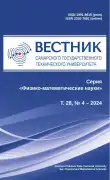Antiplane axisymmetric elastic-plastic shear in an isotropic hardening material
- Authors: Sevastyanov G.M.1
-
Affiliations:
- Institute of Machinery and Metallurgy, Khabarovsk Federal Research Center, Far-East Branch of RAS
- Issue: Vol 28, No 4 (2024)
- Pages: 740-758
- Section: Mechanics of Solids
- URL: https://journal-vniispk.ru/1991-8615/article/view/311041
- DOI: https://doi.org/10.14498/vsgtu2102
- EDN: https://elibrary.ru/KQCUGA
- ID: 311041
Cite item
Full Text
Abstract
The paper presents an analytical solution to the problem of axisymmetric antiplane shear. The deformable material is enclosed between two cylindrical surfaces, one of which is fixed, and the other moves along the generatrix. This problem models a shear-off testing scheme. We use a geometrically nonlinear formulation of the elastic-plastic problem, taking the multiplicative decomposition of the deformation gradient tensor into elastic and plastic parts. The elastic properties of the specimen are described by the Mooney–Rivlin hyperelastic model. We consider an isotropic hardening material with the hardening law that is an arbitrary monotonic function of the accumulated plastic strain. The Tresca yield condition is utilized. The original nonlinear coupled system of partial differential equations is reduced to ordinary linear differential equations, the solution of which requires the calculation of definite integrals. The resulting solution includes deformation in the elastic range, the initiation of plastic flow, propagation of the plastic deformation region, and subsequent intensive plastic flow. The solution is illustrated with examples of materials with linear hardening, quadratic hardening, and Voce-type hardening with saturation. For these examples, ''force – displacement'' relationships, the distribution of accumulated plastic strain over the sample cross-section, and data on the distortion of material fibers, which were located in the radial direction before deformation, are
presented.
Full Text
##article.viewOnOriginalSite##About the authors
Georgiy M. Sevastyanov
Institute of Machinery and Metallurgy, Khabarovsk Federal Research Center, Far-East Branch of RAS
Author for correspondence.
Email: akela.86@mail.ru
ORCID iD: 0000-0003-4755-5305
SPIN-code: 9223-1950
Scopus Author ID: 56803833800
ResearcherId: M-8548-2016
https://www.mathnet.ru/person59678
Cand. Phys. & Math. Sci.; Leading Researcher; Lab. of Mechanics of Materials and Structures
Russian Federation, 681005, Komsomolsk-on-Amur, Metallurgov st., 1References
- Shutov A. V., Kaygorodtseva A. A. Sample shapes for reliable parameter identification in elasto-plasticity, Acta Mech., 2020, vol. 231, pp. 4761–4780. DOI: https://doi.org/10.1007/s00707-020-02758-9.
- Arutyunyan N. Kh., Radayev Yu. N. Elastoplastic torsion of a cylindrical rod for finite deformations, J. Appl. Math. Mech., 1989, vol. 53, no. 6, pp. 804–811. DOI: https://doi.org/10.1016/0021-8928(89)90090-7.
- Sevastyanov G. M., Burenin A. A. Finite strain upon elastic-plastic torsion of an incompressible circular cylinder, Dokl. Phys., 2018, vol. 63, pp. 393–395. EDN: NFBQYY. DOI: https://doi.org/10.1134/S1028335818090094.
- Sevastyanov G. M., Bormotin K. S. Finite-strain elastic-plastic torsion: Analytical and FEM modeling for nonmonotonically hardening polymers, PNRPU Mechanics Bulletin, 2023, no. 3, pp. 124–136. EDN: WQVCPT. DOI: https://doi.org/10.15593/perm.mech/2023.3.11.
- Sevastyanov G. M. Finite-strain elastic-plastic torsion: Comparison of von Mises and Tresca materials, Materials Physics and Mechanics, 2023, vol. 51, no. 2, pp. 140–150. EDN: KEMBBZ. DOI: https://doi.org/10.18149/MPM.5122023_13.
- Xue Z., Pontin M. G., Zok F. W., Hutchinson J. W. Calibration procedures for a computational model of ductile fracture, Eng. Fract. Mech., 2010, vol. 77, no. 3, pp. 492–509. DOI: https://doi.org/10.1016/j.engfracmech.2009.10.007.
- Tvergaard V., Hutchinson J. W. Numerical simulation of cropping, J. Appl. Mech., 2014, vol. 81, no. 7, 071002. DOI: https://doi.org/10.1115/1.4026891.
- Aleksandrov S. E., Goldstein R. V. Motion of a rigid bar in a rigid-viscoplastic medium: The influence of the model type on the solution behavior, Mech. Solids, 2015, vol. 50, no. 4, pp. 389–396. EDN: UZWWOB. DOI: https://doi.org/10.3103/S0025654415040044.
- Alexandrov S., Date P. An alternative interpretation of axial friction test results for viscoplastic materials, Mech. Time-Depend. Mater., 2018, vol. 22, pp. 259–271. EDN: VBBPGU. DOI: https://doi.org/10.1007/s11043-017-9372-x.
- Burenin A. A., Kovtanyuk L. V., Mazelis A. L. Development of a rectilinear axisymmetric viscoplastic flow and elastic aftereffect after its stop, J. Appl. Mech. Tech. Phys., 2010, vol. 51, no. 2, pp. 261–268. EDN: MXCWLJ. DOI: https://doi.org/10.1007/s10808-010-0036-8.
- Liu I. S. A note on the Mooney–Rivlin material model, Continuum Mech. Thermodyn., 2012, vol. 24, pp. 583–590. DOI: https://doi.org/10.1007/s00161-011-0197-6.
- Kellermann D. C., Attard M. M. An invariant-free formulation of neo-Hookean hyperelasticity, ZAMM, 2016, vol. 96, no. 2, pp. 233–252. DOI: https://doi.org/10.1002/zamm.201400210.
- Korobeynikov S. N. Families of Hooke-like isotropic hyperelastic material models and their rate formulations, Arch. Appl. Mech., 2023, vol. 93, pp. 3863–3893. EDN: GMCDFC. DOI: https://doi.org/10.1007/s00419-023-02466-5.
- Lee E. H. Elastic-plastic deformation at finite strains, J. Appl. Mech., 1969, vol. 36, no. 1, pp. 1–6. DOI: https://doi.org/10.1115/1.3564580.
- Levitas V. I. Large deformation of materials with complex rheological properties at normal and high pressure. New York, Nova Science Publ., 1996.
- Feng B., Levitas V. I., Hemley R. J. Large elastoplasticity under static megabar pressures: Formulation and application to compression of samples in diamond anvil cells, Int. J. Plasticity, 2016, vol. 84, pp. 33–57. DOI: https://doi.org/10.1016/j.ijplas.2016.04.017.
- Rogovoi A. A. Formalizovannyi podkhod k postroeniiu modelei mekhaniki deformiruemogo tverdogo tela. Chast' II [Formalized Approach to Constructing Models of the Mechanics of a Deformable Solid. Part II]. Moscow; Izhevsk, Izhevskii Institut Komp’iuternykh Issledovanii, 2023, 318 pp. (In Russian)
- Sevastyanov G. M., Begun A. S., Burenin A. A. Finite-strain elastic-plastic circular shear in materials with isotropic hardening, Prikl. Mat. Mekh., 2024, vol. 88, no. 2, pp. 313–340 (In Russian). EDN: XUAKYF. DOI: https://doi.org/10.31857/S0032823524020108.
Supplementary files











